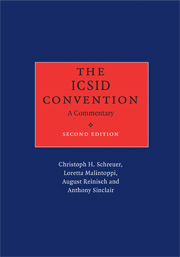Book contents
- Frontmatter
- Contents
- Foreword by Professor Sir Elihu Lauterpacht, CBE, QC
- Authors' preface to the second edition
- Table of cases
- List of abbreviations
- Text of the ICSID Convention
- Procedural calendar
- PREAMBLE
- CHAPTER I International Centre for Settlement of Investment Disputes
- CHAPTER II Jurisdiction of the Centre
- CHAPTER III Conciliation
- CHAPTER IV Arbitration
- CHAPTER V Replacement and Disqualification of Conciliators and Arbitrators
- Article 56 Replacement
- Article 57 Proposal to Disqualify
- Article 58 Decision to Disqualify
- CHAPTER VI Cost of Proceedings
- CHAPTER VII Place of Proceedings
- CHAPTER VIII Disputes between Contracting States
- CHAPTER IX Amendment
- CHAPTER X Final Provisions
- Final Clause
- Consolidated bibliography
- Index by article
- Index by subject
Article 58 - Decision to Disqualify
from CHAPTER V - Replacement and Disqualification of Conciliators and Arbitrators
Published online by Cambridge University Press: 07 September 2010
- Frontmatter
- Contents
- Foreword by Professor Sir Elihu Lauterpacht, CBE, QC
- Authors' preface to the second edition
- Table of cases
- List of abbreviations
- Text of the ICSID Convention
- Procedural calendar
- PREAMBLE
- CHAPTER I International Centre for Settlement of Investment Disputes
- CHAPTER II Jurisdiction of the Centre
- CHAPTER III Conciliation
- CHAPTER IV Arbitration
- CHAPTER V Replacement and Disqualification of Conciliators and Arbitrators
- Article 56 Replacement
- Article 57 Proposal to Disqualify
- Article 58 Decision to Disqualify
- CHAPTER VI Cost of Proceedings
- CHAPTER VII Place of Proceedings
- CHAPTER VIII Disputes between Contracting States
- CHAPTER IX Amendment
- CHAPTER X Final Provisions
- Final Clause
- Consolidated bibliography
- Index by article
- Index by subject
Summary
INTRODUCTION
Art. 58 is closely related to Art. 57 and deals with the procedure on a proposal to disqualify a conciliator or arbitrator. It also deals with the filling of a vacancy in case there is a decision to disqualify.
The drafts leading to Art. 58 show considerable change (History, Vol. I, pp. 264, 266) but relatively little discussion. The changes concern the question of who would make the decision on the proposal to disqualify (see para. 4 infra) and the method for the replacement of any person who has been disqualified (see para. 17 infra).
Like Art. 57, Art. 58 applies to a member of a conciliation commission or of an arbitral tribunal. By its terms, it does not apply to a member of an ad hoc committee constituted in accordance with Art. 52(3) (see Art. 52, paras. 549–552; Art. 57, para. 4). Nevertheless, in Vivendi v. Argentina a challenge to the President of the ad hoc Committee was treated in accordance with the procedure for the challenge of arbitrators and was decided by the other two members of the Committee (see Art. 57, para. 5).
- Type
- Chapter
- Information
- The ICSID ConventionA Commentary, pp. 1209 - 1213Publisher: Cambridge University PressPrint publication year: 2009



